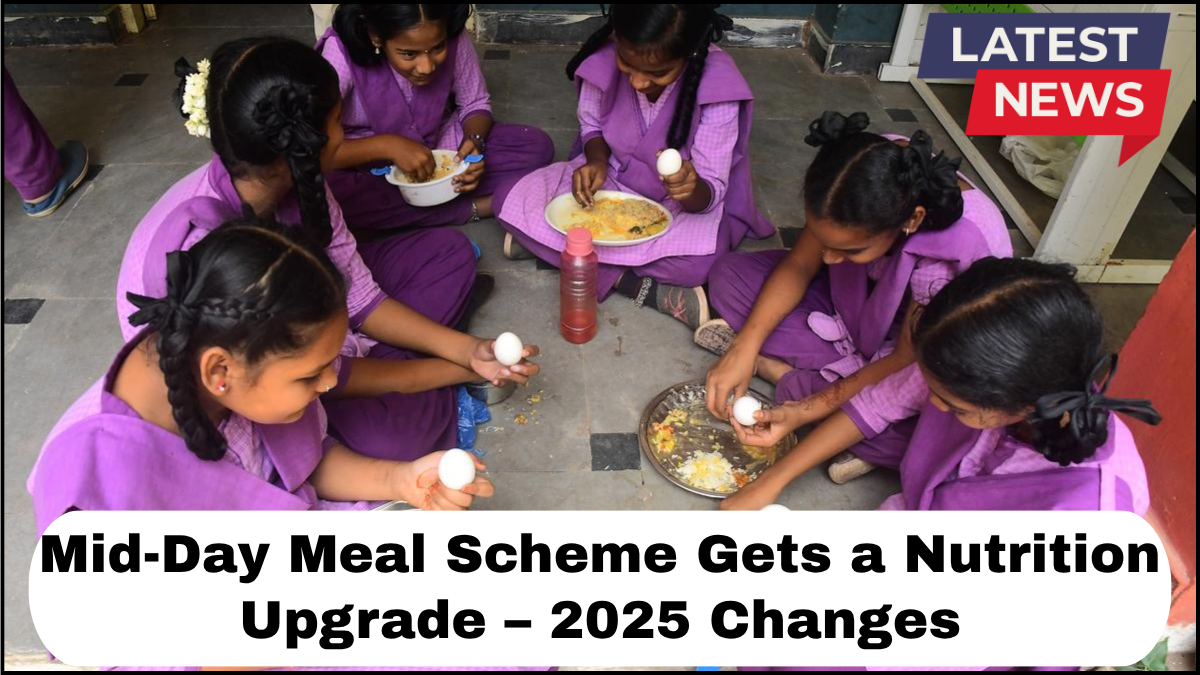India’s Mid-Day Meal Scheme has long been a pillar of public welfare, aimed at improving school enrollment, attendance, and nutrition among children. In 2025, the scheme is undergoing a significant transformation, focused on enhanced nutritional standards, diversified meal plans, and a more tech-driven monitoring system. These changes are aligned with the broader Nutrition 2025 goals that aim to tackle child malnutrition comprehensively.

What Is the Mid-Day Meal Scheme?
Launched in 1995, the Mid-Day Meal Scheme provides free lunches to schoolchildren in government and government-aided schools across India. It was designed to boost both nutrition and literacy by addressing two major barriers to education—hunger and poverty. With over 11 crore children currently benefiting from the scheme, it remains the world’s largest school meal program.
What’s New in 2025?
In line with the Nutrition 2025 roadmap, the Mid-Day Meal Scheme has been revamped to offer not just more food, but better food. Here’s a breakdown of the key updates:
1. Introduction of Region-Specific Menus
To ensure cultural relevance and better local sourcing, state governments now have greater flexibility to design region-specific menus. For example:
-
In Tamil Nadu, millet-based dishes like ragi koozh are included twice a week.
-
In Punjab, meals now include fortified paratha with vegetable curry.
-
In the Northeast, rice-based meals with locally sourced greens and fish have been prioritized.
This move respects dietary habits while maximizing nutrient absorption from familiar ingredients.
2. Inclusion of Breakfast
In a major shift, the scheme now provides a nutritious breakfast in addition to lunch for students up to Class 8. Studies have consistently shown that a morning meal improves concentration, memory, and overall classroom performance.
-
The breakfast menu includes items like poha, upma, eggs, or milk with fruits.
-
It ensures children do not begin their academic day on an empty stomach, which was a major concern in earlier assessments.
3. Enhanced Nutritional Standards
The 2025 update includes a significant upgrade in nutritional benchmarks. Meals must now meet higher daily requirements of protein, iron, calcium, and essential vitamins.
-
Iron-rich items like spinach, legumes, and fortified cereals are more prominent.
-
Regular use of iodized salt and fortified cooking oil is mandated.
-
Weekly inclusion of eggs or dairy (as per regional acceptability) is encouraged.
4. Integration with Nutrition 2025 Goals
These updates are synchronized with India’s broader Nutrition 2025 agenda, which aims to reduce child stunting, underweight prevalence, and anemia among school-aged children.
-
A new data dashboard connects school-level data with district and state nutrition databases.
-
This integration helps policymakers track progress in real-time and adjust strategies as needed.
5. Stronger Monitoring and Accountability
A digital monitoring system now ensures better transparency and compliance.
-
Schools are required to upload meal images and nutritional data weekly.
-
Real-time feedback and complaint mechanisms are integrated into a centralized mobile app.
-
Third-party audits will be conducted quarterly to assess meal quality and hygiene.
6. Community and NGO Participation
The revamped scheme actively encourages community kitchens and NGO partnerships.
-
Organizations with proven track records in child nutrition, such as Akshaya Patra, are scaling up operations.
-
Parents’ committees have been given more oversight powers to inspect kitchens and review menus.
7. Nutrition Education in the Curriculum
To complement improved meals, schools will now include basic nutrition education as part of life skills and health classes.
-
Children will learn about balanced diets, personal hygiene, and the importance of hydration.
-
This initiative aims to create long-term behavioral changes in food habits.
The Road Ahead
The updated Mid-Day Meal Scheme is not just about feeding children; it’s about nourishing their future. By aligning with Nutrition 2025, India is making a strategic move to break the cycle of malnutrition and educational underachievement. However, success will depend on consistent funding, state-level commitment, and active participation from communities and school administrators.
Frequently Asked Questions (FAQs)
Q1. What is the objective of the Mid-Day Meal Scheme 2025 update?
A: The 2025 upgrade aims to improve the nutritional quality of meals, include breakfast, ensure regional dietary alignment, and integrate better monitoring systems to align with Nutrition 2025 goals.
Q2. Are breakfast meals now compulsory in all schools under the scheme?
A: Yes, breakfast is now included for students from Class 1 to 8 across all states, although the menu can be adjusted based on regional preferences.
Q3. How is food quality being monitored under the new guidelines?
A: Through a centralized digital monitoring system with real-time data uploads, community oversight, third-party audits, and a dedicated grievance redressal mechanism.
Q4. What role do local communities play in the new scheme?
A: Parents’ committees and local NGOs are now key stakeholders, helping monitor meal quality, inspect kitchens, and suggest improvements.
Q5. How does this tie into the broader Nutrition 2025 goals?
A: The upgraded scheme directly supports goals like reducing child malnutrition, anemia, and promoting better eating habits in schools.
click here to learn more